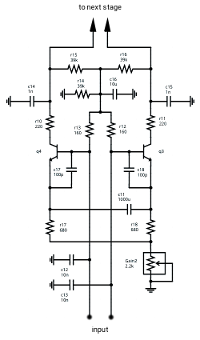• Signal to Noie Ratio
The input signal is low enough (<1mV, sometimes below 0.1mV). It is a real challenge to build a low-noise amplifier for this input level.
Fortunately, it is not impossible: semiconductor devices are available with very good noise parameters.
• Distortion
In this case the low level of the input signal comes in handy: in general, higher input signal
produces higher distortion in such devices. In addition, we can use amplifiers without feedback
(which is generally preferred in the audiophile world) and the distortion of such a circuit can be
theoretically calculated or simulated easily and exactly (see the details later).
• Frequency Response
Fortunately, this stage does not have any parts which could bother the frequency response (at least in the audio frequency range), so the flat response
can be reached easily. Only the decoupling capacitor (which can even be omitted in some cases) could change it, but it is calibrated for noise and therefore
its corner point is out of the audio range (see the
noise calculation page for details).





